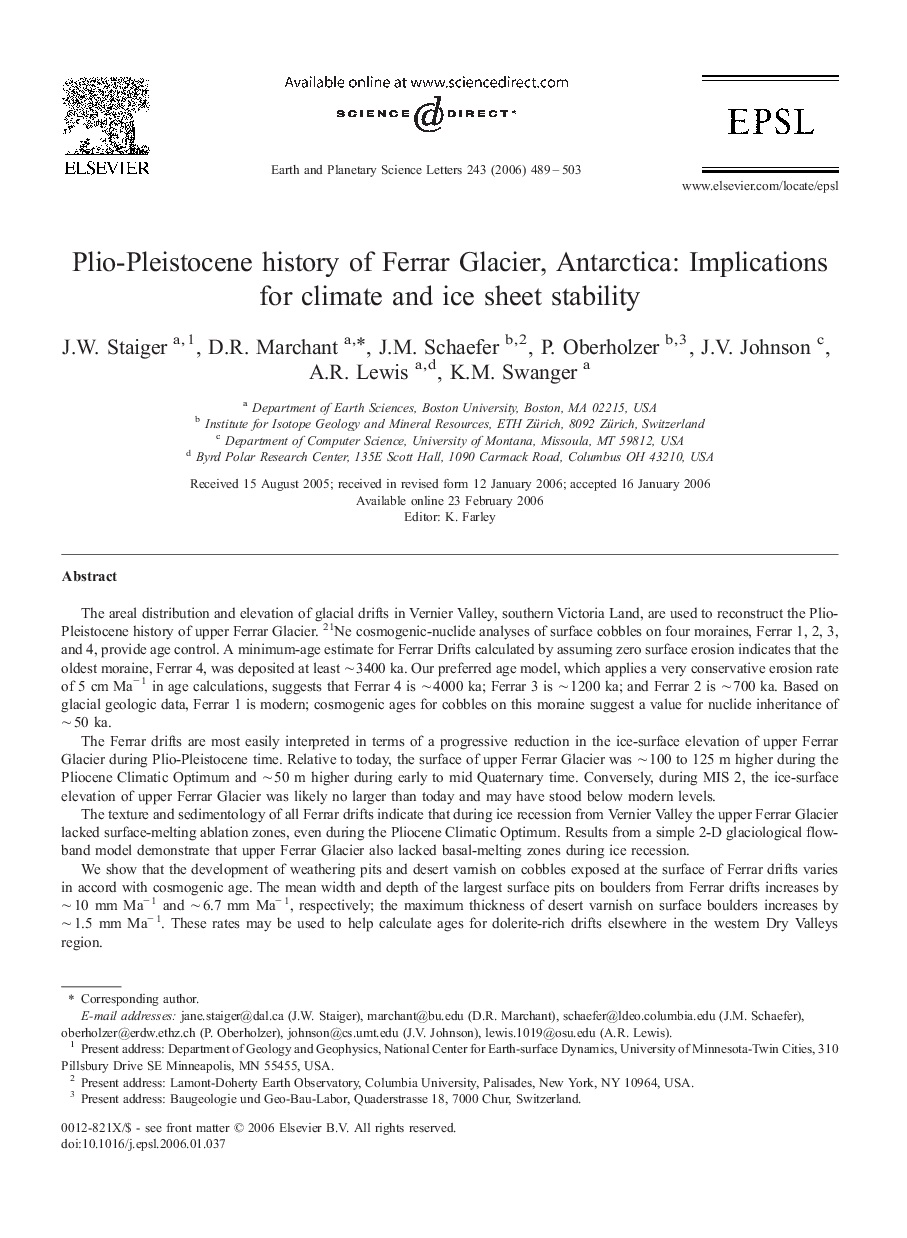| کد مقاله | کد نشریه | سال انتشار | مقاله انگلیسی | نسخه تمام متن |
|---|---|---|---|---|
| 4680899 | 1634948 | 2006 | 15 صفحه PDF | دانلود رایگان |

The areal distribution and elevation of glacial drifts in Vernier Valley, southern Victoria Land, are used to reconstruct the Plio-Pleistocene history of upper Ferrar Glacier. 21Ne cosmogenic-nuclide analyses of surface cobbles on four moraines, Ferrar 1, 2, 3, and 4, provide age control. A minimum-age estimate for Ferrar Drifts calculated by assuming zero surface erosion indicates that the oldest moraine, Ferrar 4, was deposited at least ∼ 3400 ka. Our preferred age model, which applies a very conservative erosion rate of 5 cm Ma− 1 in age calculations, suggests that Ferrar 4 is ∼ 4000 ka; Ferrar 3 is ∼ 1200 ka; and Ferrar 2 is ∼ 700 ka. Based on glacial geologic data, Ferrar 1 is modern; cosmogenic ages for cobbles on this moraine suggest a value for nuclide inheritance of ∼ 50 ka.The Ferrar drifts are most easily interpreted in terms of a progressive reduction in the ice-surface elevation of upper Ferrar Glacier during Plio-Pleistocene time. Relative to today, the surface of upper Ferrar Glacier was ∼ 100 to 125 m higher during the Pliocene Climatic Optimum and ∼ 50 m higher during early to mid Quaternary time. Conversely, during MIS 2, the ice-surface elevation of upper Ferrar Glacier was likely no larger than today and may have stood below modern levels.The texture and sedimentology of all Ferrar drifts indicate that during ice recession from Vernier Valley the upper Ferrar Glacier lacked surface-melting ablation zones, even during the Pliocene Climatic Optimum. Results from a simple 2-D glaciological flow-band model demonstrate that upper Ferrar Glacier also lacked basal-melting zones during ice recession.We show that the development of weathering pits and desert varnish on cobbles exposed at the surface of Ferrar drifts varies in accord with cosmogenic age. The mean width and depth of the largest surface pits on boulders from Ferrar drifts increases by ∼ 10 mm Ma− 1 and ∼ 6.7 mm Ma− 1, respectively; the maximum thickness of desert varnish on surface boulders increases by ∼ 1.5 mm Ma− 1. These rates may be used to help calculate ages for dolerite-rich drifts elsewhere in the western Dry Valleys region.The general stability of the ice-surface elevation of upper Ferrar Glacier, and of the landscape in Vernier Valley, suggests minimal climatic amelioration in the upland region of the Dry Valleys during the last ∼ 4 Ma.
Journal: Earth and Planetary Science Letters - Volume 243, Issues 3–4, 30 March 2006, Pages 489–503